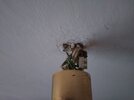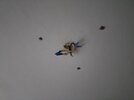- Joined
- 2 Jun 2024
- Messages
- 8
- Reaction score
- 1
- Country

Hi ,
So i have this annoying problem i have no idea how to deal with best. What i really want is to replace old hook type ceiling lamp to a new led type one .
Problem is mounting , the old one is so old , so it has no electric box neither any mounting parts , just got to hang on wires . Added a picture below. All i want to is to replace this contraption to flat one mounted with screws . Any suggestions ? Thank you.
So i have this annoying problem i have no idea how to deal with best. What i really want is to replace old hook type ceiling lamp to a new led type one .
Problem is mounting , the old one is so old , so it has no electric box neither any mounting parts , just got to hang on wires . Added a picture below. All i want to is to replace this contraption to flat one mounted with screws . Any suggestions ? Thank you.



